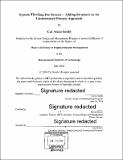| dc.contributor.advisor | Bryan Moser. | en_US |
| dc.contributor.author | Smith, Cal Alden | en_US |
| dc.contributor.other | Massachusetts Institute of Technology. Integrated Design and Management Program. | en_US |
| dc.date.accessioned | 2018-10-15T20:23:23Z | |
| dc.date.available | 2018-10-15T20:23:23Z | |
| dc.date.copyright | 2018 | en_US |
| dc.date.issued | 2018 | en_US |
| dc.identifier.uri | http://hdl.handle.net/1721.1/118516 | |
| dc.description | Thesis: S.M. in Engineering and Management, Massachusetts Institute of Technology, System Design and Management Program, 2018. | en_US |
| dc.description | Cataloged from PDF version of thesis. | en_US |
| dc.description | Includes bibliographical references (pages 139-141). | en_US |
| dc.description.abstract | When many companies are presented with the knowledge of new tools and techniques for System Architecture, Systems Engineering and Project Management as part of a System Thinking approach, they initially show great interest and a desire to institute change to their current culture. Yet, when presented with an opportunity to apply these new tools and techniques in the next project, they perhaps become reluctant to institute the change because of a perceived risks in integrating unfamiliar methods. This reluctance may be a bias based primarily on their own perception of past success using the company's internally developed processes and practices, and a belief that change may negatively affect results. But are these modern System Thinking techniques really new to them? Is it possible that these companies have naturally evolved toward practicing the newer System Thinking techniques without realizing it, driven by the accumulation of practical knowledge and lessons learned, but performed in an unstructured manner. This paper's research has found in looking at a well-established company with a track record of successful projects, Lawrence Livermore National Laboratory (LLNL), that there are indications that they have become significantly align to the current System Thinking approaches. The success of LLNL's current processes and practices relies heavily on the experience and the expertise of individuals who can process many of the projects architectural assessments, trades, plans and analytics within their cognitive abilities and derived practices. This paper, however, finds that this reliance on Experts may not be the primary force behind their success and the natural progression to Systems Thinking. The success and progression in System Thinking seems to be stimulated by the project team mix of Experts and Non-Experts, and by empowering the Non-Experts with the ability to question and request clarification of rationale concerning the Expert opinions. Non- Experts appear to play a critical role in project team success in System Thinking, especially in an Expert dominate Ecosystems such as those at LLNL. The risk in the LLNL project ecosystems is that this progression to System Thinking has occurred with little structural change in terms of documentation, analytics and metrics. This structural weakness appears to be actively mitigated through management oversight, which carries its own level of risk, often generating a single point of failure opportunity in the project system. There is evidence that an integrated and distributed approach to the System Thinking activities would best support LLNL projects. With staffing turnover, retirements and natural attrition, the company's current unstructured processes and practices are challenged, often requiring retirees to return as consultants or additional resources to be added to force the current unstructured practices to succeed. This paper's research provides information to help in (1) evaluating current project approach for evidence of Systems Thinking and (2) determining the effect of the addition of System Thinking structure and methods to reduce future project risk. | en_US |
| dc.description.statementofresponsibility | by Cal Alden Smith. | en_US |
| dc.format.extent | 141 pages | en_US |
| dc.language.iso | eng | en_US |
| dc.publisher | Massachusetts Institute of Technology | en_US |
| dc.rights | MIT theses are protected by copyright. They may be viewed, downloaded, or printed from this source but further reproduction or distribution in any format is prohibited without written permission. | en_US |
| dc.rights.uri | http://dspace.mit.edu/handle/1721.1/7582 | en_US |
| dc.subject | Engineering and Management Program. | en_US |
| dc.subject | Integrated Design and Management Program. | en_US |
| dc.title | System thinking for success : adding structure to an unstructured process approach | en_US |
| dc.type | Thesis | en_US |
| dc.description.degree | S.M. in Engineering and Management | en_US |
| dc.contributor.department | Massachusetts Institute of Technology. Engineering and Management Program | en_US |
| dc.contributor.department | Massachusetts Institute of Technology. Integrated Design and Management Program. | en_US |
| dc.identifier.oclc | 1054786691 | en_US |
